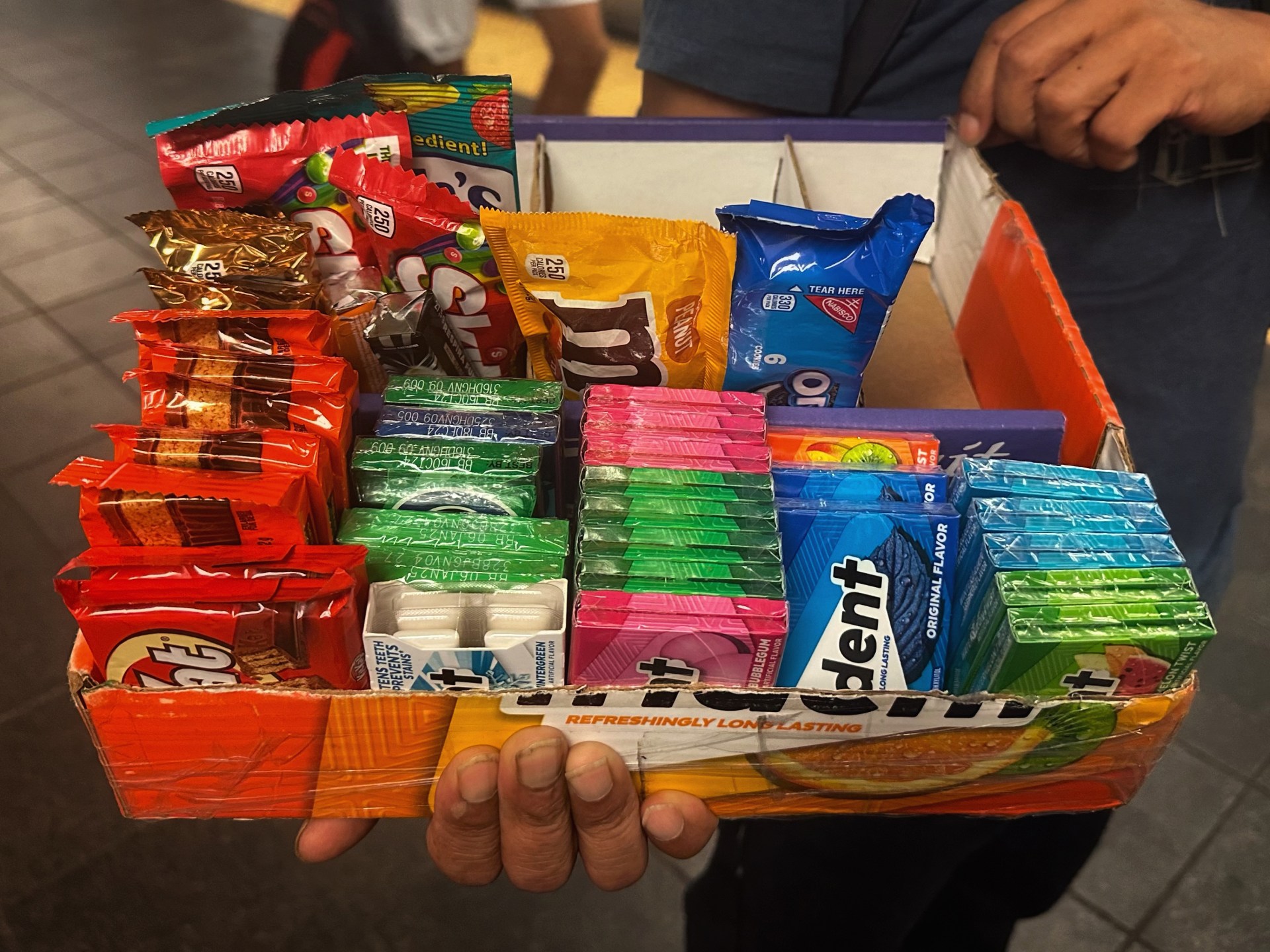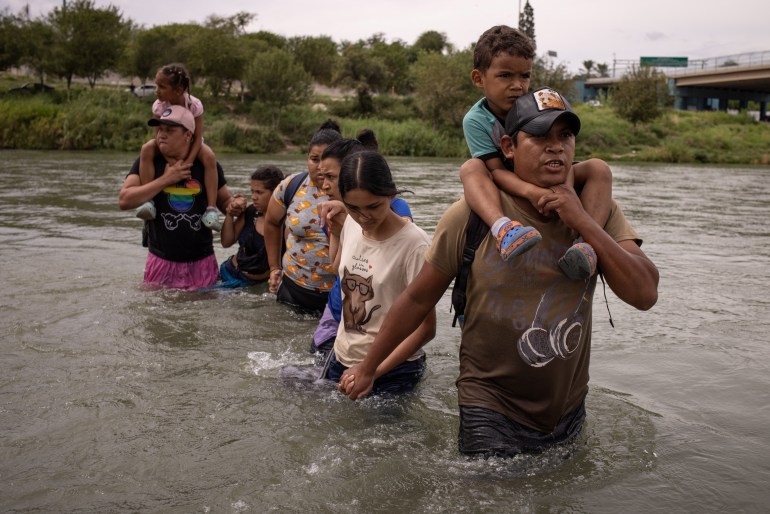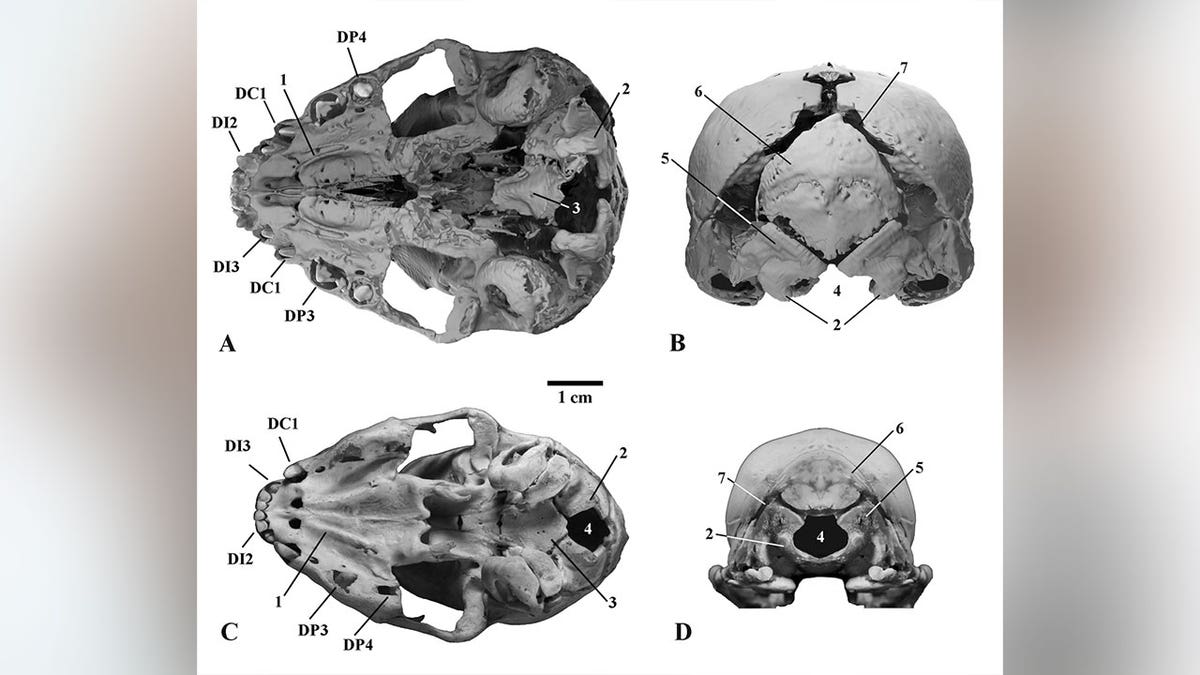World
‘The only way for us to survive’: The life of a New York City candy seller

New York City, United States – A clock on the electronic display flickers to noon above the bustling Times Square subway station in New York City. Amid the lunchtime crowd of commuters and tourists stands María, a 31-year-old single mother from Ecuador whose daily life revolves around this transit hub.
It is here, in the tunnels underneath the city, that María earns the money she needs to survive.
On her back is her two-year-old daughter, and in her hands is a colourful tray of candy, crammed with packages of M&Ms and Kit Kat chocolates and sticks of Trident gum.
From the Times Square station, María can hop on and off the Number 7 train, a popular link to the borough of Queens. As she walks from one carriage to the next, she repeats “candy” and “dollar” — two of the few words she knows in English — hoping to make a sale.
Most people, however, look away. Others become aggressive, María said.
New York City is in the midst of an immigration crisis, with more than 113,300 asylum seekers arriving since 2022 — and too few shelters to house them. With the city’s immigration policies in the spotlight, María’s interactions with the public can be tense.
“People insult us or record us without authorisation, accusing us of importing bad habits and poverty from home,” María said. “They don’t understand our situation.”
María — who is using a pseudonym to protect her privacy — is part of a population of largely Ecuadorian candy sellers who make a living on the New York City subway system.
Peddling sweets is familiar work for María: It is the same job she used to do in her hometown in the province of Cotopaxi. But it is also a necessity. Without legal papers authorising her stay in the US, finding steady employment is difficult, seemingly impossible.
“It’s what my cousin and other women from Ecuador I know do because there are no job opportunities. It’s the only way for us to survive,” María explained.
But each sale only nets her one dollar, maybe two. After working 13 hours straight, from 7am to 8pm, she might come home with $50 on a good day, $10 on a bad one.
Still, the pressures in her home country forced her and other Ecuadorian migrants to arrive here and eke out a living on the subway lines.

A ‘third wave’ of Ecuadorian migration
By the end of September, the US Border Patrol had apprehended 117,487 Ecuadorians for the fiscal year 2023 — more than four times the previous year’s total.
Anthropologist Soledad Alvarez, a professor at the University of Illinois Chicago, considers this spike part of Ecuador’s third major “wave” of emigration since the 1980s.
She told Al Jazeera the current exodus began in 2014, “caused by the decline in oil prices”.
“Then the pandemic came and hit Ecuador severely,” she said. “Since then, this crisis has deepened under the administrations of Lenin Moreno and Guillermo Lasso, leading to substantial migration in recent years.”
The National Institute of Statistics and Censuses in Ecuador (INEC) reports that income poverty — defined as earnings of less than $89.29 per month — reached 27 percent in June. Extreme poverty, meanwhile, hit 10.8 percent.
Alvarez also points to the deteriorating security situation in Ecuador as a motivation for leaving.
“Increasing violence, fuelled by insecurity and drug trafficking, has forced thousands of Ecuadorians to forcibly leave in recent years,” Alvarez said.

Last year was the worst for criminal violence, with 25 homicides per 100,000 people. And in 2023, the situation escalated. The homicide rate in Ecuador is now the fourth highest in Latin America.
María witnessed many of her neighbours and acquaintances leaving as a result of the violence.
The tipping point for her was when the father of her child passed away during the COVID-19 pandemic. She was alone, racking up debt, and what little she earned was sometimes stolen as the country’s crime rates ticked upwards.
“It’s not just jobs and food that we’re lacking. Ecuador has become extremely dangerous. We now live in constant fear,” María said.
She left Ecuador in the first week of April, travelling north through the Darién Gap, a dangerous stretch of jungle that connects South America to Central America. For two months, she walked and caught buses, spending $3,000 in expenses for the journey.
María said arrived in the US three months ago. She and her child now live in Elmhurst, Queens, where she rents a small space in the living room of her cousin’s family for $800 a month.

Risks to selling candy
Back home in Ecuador, María said selling candy was primarily women’s work. But in New York, she competes with men and even children on the subway platforms, hawking candy she bought at a wholesale store.
The presence of young children has sparked particular concern among the public. Some subway riders have taken to social media to vent their frustration.
“This is child exploitation and should be banned,” one user on TikTok said. Another called on law enforcement to intervene.
Under New York state law, child labour under age 14 is largely prohibited and can be regarded as abuse. But Alvarez, the anthropologist, said many new arrivals from Ecuador are unaware of the local laws.
“They are ensnared in a reality where sheer survival is their sole objective. They grapple with traumas and escape from destitute circumstances,” she told Al Jazeera.

Additionally, the Metropolitan Transportation Authority (MTA) prohibits unauthorised commercial activity in the subway. Police can fine the candy sellers $50 if they catch them, so María is constantly on the lookout for their uniforms.
“We run away from the police when we see them. A ticket can cost what we earn in a day. Police also tell us that we can lose the custody of our children,” she said.
Gustavo Espinoza, a community organiser, explained to Al Jazeera that there are services and organisations working to educate new immigrants about the resources available to them.
However, those without legal immigration papers are often reluctant to seek assistance due to their fear of deportation, Espinoza said. They “live in constant fear”.
“There is evidently a barrier,” he explained. “There are organisations that want to help but they don’t reach the immigrants who need assistance but are afraid to ask or seek help.”
In August, New York City Mayor Eric Adams estimated the city could end up paying up to $12bn to support migrants over the next three years.
In its $107bn budget for 2024, the city council approved $16m for Promise NYC, a programme that offers stipends for childcare to low-income parents, including undocumented ones.

But advocates say those efforts are not enough to help migrants and asylum seekers like María, who rarely goes anywhere without her child.
Some are pushing for the New York State Senate to pass a 2023 bill that would offer universal childcare to all parents, regardless of immigration status. But that legislation is still pending.
For María and others, though, there seems to be no alternative but to carry on with their daily routines, children in tow.
María’s daughter rides on her back throughout the day: She only ever sets the two-year-old down briefly, keeping a watchful eye on the child. On top of her cargo of candy to sell, María carries around cookies and a bottle of milk to feed her child, who often dozes as her mother works.
“I can’t leave my daughter alone at home. Nobody will care for her,” María said.
Life, at least for the time being, means balancing both childcare and selling candy in the subway: “There’s no other option.”

World
Ron Ely, Star of TV’s Tarzan, Cause of Death Revealed

ad
World
Scientists study ‘very rare’ frozen remains of 35,000-year-old saber-toothed cub

A mummified saber-toothed cub of a catlike animal dating back 35,000 years was left almost perfectly preserved in Siberia’s permafrost.
The remains had been found back in 2020, northeast of Yakutia, Russia. Research regarding the study of the cub was published in the journal Scientific Reports on November 14, 2024.
The discovery of frozen remains from the Late Pleistocene period is “very rare,” according to the published research, though most discovered in Russia lie in the Indigirka River basin, the authors note.
The mummified saber-tooth cub found in Siberia’s permafrost was studied by scientists and found to have been buried around 35,000 years ago. (Alexey V. Lopatin)
12-YEAR-OLD BOY STUMBLES UPON STUNNING ANCIENT FIND WHILE WALKING DOG IN ENGLAND: ‘RELATIVELY RARE’
The mummified cub remained well-preserved, frozen in time for thousands of years. The frozen nature of this find left it in impressive condition, even still containing fur.
“The mummy body is covered with short, thick, soft, dark brown fur with hair about 20–30 mm long,” the authors wrote in the published research, also pointing out that the fur that was located on the back and neck of the cub was longer than the hair that was found on the legs.
The head of the mummy was also left well-preserved, down to its chest, front arms and paws.
IRISH FARMER FINDS NEAR-60-POUND SLAB OF ANCIENT BOG BUTTER ON HIS LAND BY ‘PURE LUCK’
The study of this find wasn’t just a unique opportunity for scientists, it also provided first-of-its kind research.
“For the first time in the history of paleontology, the appearance of an extinct mammal that has no analogues in the modern fauna has been studied,” the authors of the study explained.

This discovery provided an extremely unique and rare opportunity for scientists to study an extinct species that was so well preserved. (Alexey V. Lopatin)
The scientists determined that the cub had died at about three weeks old. It was identified by the authors of the study as belonging to the species Homotherium latidens and had many differentiations from a modern lion cub of a similar age.
The shape of the muzzle displayed by the mummified cub, which had a large mouth and small ears, plus a “massive” neck, long forelimbs and a darker colored coat, were all among key differences from today’s modern lion cubs that scientists observed.
2,000-YEAR-OLD ROMAN ROAD DISCOVERED BY ARCHAEOLOGISTS IN LONDON
Scientists also worked in their research to find out how the extinct species was able to survive through frigid temperatures.
Large contributors to their survival were the shape of the large paws and absence of carpal pads. Scientists believe these elements helped them get through the snow.
In recent years, there have been other ancient animals found in Siberian permafrost.

Analysis of the cub’s skull helped scientists identify it as belonging to the genus Homotherium. (Alexey V. Lopatin)
For example, in 2021, a mummified wolf was discovered that dated back over 44,000 years, Live Science reported in June 2024.
World
More than 100 Palestinians killed in Israeli attacks on Gaza in 48 hours

Director of the Kamal Adwan hospital says several staff wounded in Israeli bombardment.
At least 120 people have been killed in Israeli attacks on Gaza in two days, Palestinian health officials said, as Israel intensified its bombardment across the besieged territory.
At least seven people were killed when a residential home was hit overnight in the Zeitoun suburb of Gaza City, health officials said on Saturday. The other deaths were recorded in central and southern Gaza.
Israeli air raids caused significant damage to al-Faruq Mosque in the Nuseirat refugee camp in central Gaza, according to a social media video verified by Al Jazeera.
Israeli forces also deepened their ground offensive and bombardment of northern Gaza, where one of the last partially operating hospitals was hit, wounding several workers.
Hussam Abu Safia, director of the Kamal Adwan Hospital, said in a statement on Saturday that Israeli forces “directly targeted the entrance to the emergency and reception area several times, as well as the hospital courtyards, electrical generators, and hospital gates”.
The bombardment “resulted in 12 injuries among doctors, nurses, and administrative staff within the emergency and reception areas”, he said.
The Israeli military rejected the allegations and said it was “not aware of a strike in the area of the Kamal Adwan Hospital” following an initial review of the situation.
On Friday, Gaza’s Ministry of Health said hospitals have fuel left for only about two days before it needs to start restricting services.
Israel’s military imposed a siege and launched a renewed ground offensive in northern Gaza last month, saying it aimed to stop Hamas fighters from waging more attacks and regrouping in the area.
The United Nations warned earlier this week that almost no aid had been delivered to northern Gaza since Israel’s renewed offensive as aid groups and food security experts warn of a famine in the area.
In a call with Defence Minister Israel Katz on Saturday, United States Defense Secretary Lloyd Austin pressed Israel to “take steps to improve the dire humanitarian condition in Gaza”, the Pentagon said.
Israel’s assault on Gaza has killed more than 44,000 people and wounded more than 104,000 since October 2023, according to Palestinian health officials.
Israel launched its assault on Gaza after the Hamas-led attacks on southern Israel on October 7, 2023, in which at least 1,139 people were killed and about 250 others seized as captives.
A spokesperson for the armed wing of Hamas, Abu Ubaida, said later on Saturday that a female Israeli captive in the group’s custody had been killed in northern Gaza in an area under attack by Israel’s forces.
“The life of another female prisoner who used to be with her remains in imminent danger,” he added, accusing the government of Prime Minister Benjamin Netanyahu of being responsible and of undermining efforts to end the war.
-

 Business7 days ago
Business7 days agoColumn: Molly White's message for journalists going freelance — be ready for the pitfalls
-

 Science4 days ago
Science4 days agoTrump nominates Dr. Oz to head Medicare and Medicaid and help take on 'illness industrial complex'
-

 Politics6 days ago
Politics6 days agoTrump taps FCC member Brendan Carr to lead agency: 'Warrior for Free Speech'
-
/cdn.vox-cdn.com/uploads/chorus_asset/file/25739950/247386_Elon_Musk_Open_AI_CVirginia.jpg)
/cdn.vox-cdn.com/uploads/chorus_asset/file/25739950/247386_Elon_Musk_Open_AI_CVirginia.jpg) Technology5 days ago
Technology5 days agoInside Elon Musk’s messy breakup with OpenAI
-

 Lifestyle6 days ago
Lifestyle6 days agoSome in the U.S. farm industry are alarmed by Trump's embrace of RFK Jr. and tariffs
-

 World6 days ago
World6 days agoProtesters in Slovakia rally against Robert Fico’s populist government
-

 News6 days ago
News6 days agoThey disagree about a lot, but these singers figure out how to stay in harmony
-

 News6 days ago
News6 days agoGaetz-gate: Navigating the President-elect's most baffling Cabinet pick


















